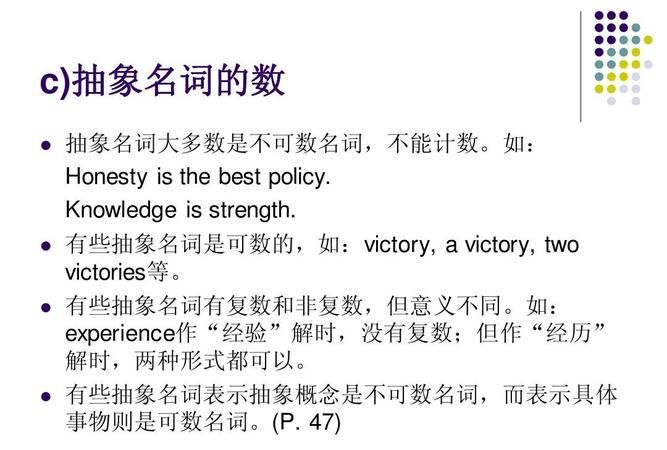本文目录
现代汉语中名词性短语有哪些
名词性短语:指语法功能相当于名词的短语。
它包括以名词为中心词的偏正短语(如“伟大的祖国”,“这些孩子”)、用名词构成的联合短语(如“工人农民”)、复指短语(如“首都北京”)、方位短语(如“桌面上”,“大楼前面”)、“的”字短语(如“打更的”)等;
某些中心词是动词、形容词的偏正短语,其定语是代词、名词或其他名词性短语,也属于名词性短语,如“他的死”,“中国的解放”,“他态度的诚恳”等。
动词性短语:指以动词为主体的短语,它的语法功能与动词相当。
动词性短语包括动宾短语(如“想睡觉”、“学文化”、“是哺乳动物”)、动补短语(如“跑得飞快”、“走过来”、“跳了一下”、“搅得他心乱如麻”);
用动词构成的联合短语(如“讨论并通过”)、连动短语(如“坐下看报”)、中心词为动词的偏正短语(也称“状中短语”,如“热烈鼓掌”、“从北京回来”、“这样画”、“一把拉住”)等。
名词性短语作用:
一般的名词性短语可以在句子中充当主语、宾语、定语等。如“人民的利益高于一切”(作主语),“大家都热爱首都北京”(作宾语),“工人农民的生活得到很大的提高”(作定语)。
“的”字短语只能作主语和宾语,如“打更的住在这里”(作主语),“大海是蔚蓝色的”(作宾语)。
表示人或事物的性质状态的短语,可以作谓语,如“他高高的个子”,“这个凳子三条腿”。
表示时间、处所的名词性短语,可以作状语,如“天快亮的时候他已经起床了”,“大家在工地上见面” 。
有的名词性短语带上成句的语调,独立应用时,就是非主谓句。如“好大的山啊!”,“一九四六年的秋天”。

英语里面的词组是什么意思
是
英语的名词性词组,首先是一个词语组合,然后它具有名词的性质和功能,通常由修饰语(名词、形容词、代词、分词及其短语、介词的短语、不定式以及它们的各种组合)和中心词(即名词)构成。
例如:a
question一个问题
a
difficult
question
一个难题
a
very
difficult
question
一个非常难的问题
a
very
difficult
English
question
一个非常难的英语问题
a
very
difficult
English
question
asked
by
him一个他问的非常难的英语问题
等等。
其实跟语文课上学到的句子成分差不多,就是找出句子主干,最终表述的中心词就是名词而已。

英语中的什么样是短语呢
比如 take over,kick out... 两个词 组在一起 成为一个 新 的 词. 本来两个不一样的意思 组在一起就成了新的意思
词组(短语)是指由两个以上的词语组合而成的一个有意义语法单位.英语词组都是习惯用语,它相当于我们汉语的成语,不能随意搭配.词组是英语句子结构中重要的成分,不可忽视.短语通常没有主语,也没有谓语动词,但是每个短语都有一定的结构和语义,在句子中形成一个重要的环节.
论功能,英语短语可分为名词短语(noun phrase)、形容词短语(adjective phrase)和副词短语(adverb phrase)及动词短语(verb phrase)四种.
名词短语,主要有三种形式,即:一名词组;二动名词组;三不定式动词组.
名词短语和名词功能一样,可在句子中充当主语,如例①;宾语,如例②;补足语,如例③:
① The state of Johore lies in the southern part of Malaysia.
② I enjoy teaching English.
③ Who is to accompany you to the airport?
①是名词组;②是动名词组;③是不定式动词组.
形容词短语也有三种,即:一介词组,如例④-⑥;二现在分词组;如例⑦-⑧;过去分词组,如例⑨-⑩:
④ The boy on my right is the monitor.
⑤ Bankers are people of great wealth.
⑥ I published books on language learning.
⑦ Hearing the scream, the small girl cried.
⑧ Have you seen the thief running for his life?
⑨ Taken aback, the boy burst into tears.
⑩ The rat, chased by a cat, ran into a ditch.
由介词组成的形容词短语紧跟在被修饰的名词之后.由现在分词或过去分词组成者,则可以在名词之前,如例⑦和⑨或名词后头,如例⑧和⑩.
副词短语主要由介词协助组成,作用和一般副词一样,修饰动词,但位置灵活,可以在句前,也可以在动词之后.例如:
11 The naughty boy was asked to stand in front of the classroom.
12 Don't run across the road. It is dangerous to do so.
13 In 1989, I stayed a few months in the University of London as a visiting scholar.
在这些短语中,由介词引荐者既有形容词的功能(见例④-⑥),又可负起副词的使命.这样一来,我们应如何判辨两者的差别呢?方法简单,就是从短语在句中的功能着手:修饰名词的是形容词性的、修饰动词的是副词性的,如:
14a The students in this class are very active.
b If you like, you may study in this class.
15a Two boys at the back of the class are talking.
b An unwell student has fallen asleep at the back of the class.
“In this class”和“at the back of the class”在14a和15 a里修饰名词“students”和“boys”,因此属形容词性短语.反之,在14b和15b中,则分别修饰动词“may study”和“has fallen asleep”,因此是副词性短语.
动词短语由动词及名词、介词或者副词等组成.
词组举例:
一、名词词组
action movie 动作片
bed time 就寝时间
Beijing Opera 京剧
computer game 电脑游戏
family name 姓氏
ice cream 冰淇淋
ID card 身份证
movie star 电影明星
pen pal/friend 笔友
phone number 电话号码
school day 学校上课日
school trip 郊游
summer camp 夏令营
talent show 天才表演
thanks for 因……而感谢
二、动词词组
act out 表演
ask for 请求,要求
be born 出生
be busy 很忙
be different from 与…...不同
be from 来/出自
be like 像
be sure 确信,相信
call…at 打……电话号码
come down to 到达,从一边来到另一边
come from 来自
do homework 做作业
eat …for lunch/breakfast/supper 午餐/早餐/晚餐吃……
eat breakfast/lunch/supper 吃早餐/午餐/晚餐
enjoy v-ing 喜欢做
fill in 填充
fill out 填充
find out 发现,查明
find out 发现,查明
get angry 生气
get home 到家
get to 到达
get up 起床
go home 回家
go on a picnic 搞野餐
go to bed 上床睡觉
go to school 上学
go to the movie 去电影院,去看电影
go to work 去上班
have a look at 看一看,看一眼
have sth for money 购某物付钱
help…with…帮助……做……
know about 关于…….知道
learn a lot about 对……了解很多
learn about 关于……了解
like v-ing 喜欢做……
listen to 听
look at 看着
match…with 与……搭配
play soccer 踢足球
play sports 做运动
play the guitar/piano 弹吉它/钢琴
play with 玩耍,与……玩
put on 穿上
sound like 听起来像
speak English 说英语
stay at home 呆在家中
take a shower 冲沐浴
take part in 参加
take turns 依次,按顺序
talk about 谈论
talk to 与……交谈
tell …about 告诉…….关于……
think of 思考,考虑
wait for 等待
wake up 醒来
watch TV 看电视
write …to….给……写信
write down 写下,抄下
三、介词词组
at home 在家
at school 上学,在学校
at the high/low price 以高价/低价……
between…and… 在……之间
for example 例如
for the reason 因为
from…to 从…..到….
in a word 一句话,总之
in blue 穿蓝色衣服
in English 用英语说
in fact 实际上,事实上
in pairs 对双,成对
in some ways 用一些方面
in the morning/afternoon/evening 在上午/下午/晚上
next to 在…..旁边
on sale 正在出售
on the back of 在……的后面或背上
on TV 看电视,通过电视
on weekends 在周末
四、形容词与副词词组
all over the world 全世界
all right 行,好吧
best wishes 最大的祝愿
every day 每天
free time 空时间
good luck 祝好运
here you are 给你
lost and found 失物招领
running star 赛跑明星
there be (is单数和不可数名词/are名词复数) 某处有……
too much 非常,很, 太
too…to 太……而不能……
very much 非常,很
五、其它词组
a little 一点
a lot 很,非常
a photo of 一张…..相相片
a set of 一套
how much 多少(钱)
how old 多大
lots of 许多,大量
what color 什么颜色
what kind 哪种
what letter 什么字母
what’s on? 发生了什么事?

英语名词做状语
[1]名词或名词词组作状语,一般置于句末。 Wait
a
minute.
等一会儿。 Come
this
way!
走这边! No
one
really
knows
why
wolves
walk
(in)single
file.排成一列行走。 [2]next/last/this/one/every/each/some/any/all+
day/month/year/Sunday等等可以直接用作状语,有些已经演化成了固定短语如all
the
year
round一年到头
all
the
time一直 We
must
get
together
again
some
day.将来某天我们必能再相聚. see
you
next
Monday. [3]一些由and或or连接所形成的名词短语如Rain
or
shine和heart
and
soul等直接作状语 Rain
or
shine,we
must
arrive
there
on
time. we
should
serve
people
heart
and
soul. [4]名词词组each/every/the
first/time,
the
instant/instance/moment/minute
所引导的时间状语从句;
the
way所直接引导的方式状语从句 例如: You
see
the
lightning
the
instant
it
happens,
but
you
hear
the
thunder
later. Every
time
I
saw
him,
I
would
like
to
listen
to
his
songs. I
came
to
the
house
the
moment
he
was
about
to
leave.

以上就是关于名词词组举例,现代汉语中名词性短语有哪些的全部内容,以及举例的词组 的相关内容,希望能够帮到您。
